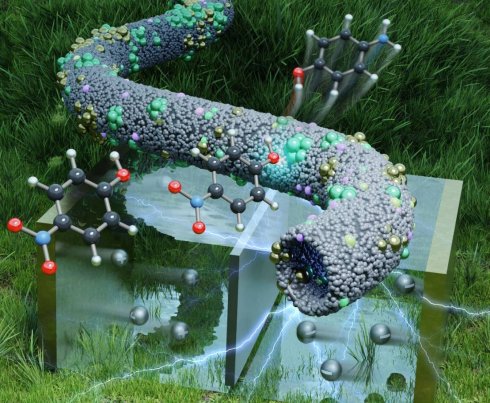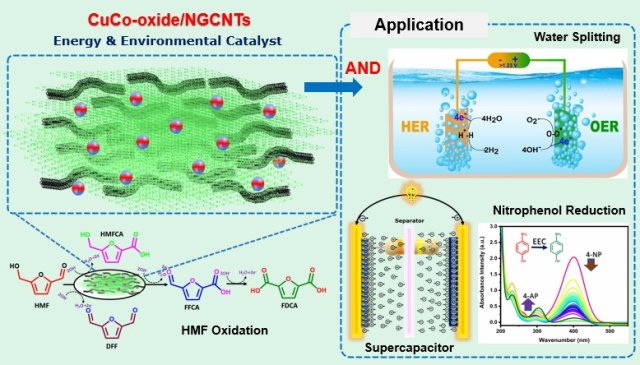New Nanomaterial Offers Breakthrough in Energy Storage and Environmental Sustainability
- Share
- Tweet
- Send to email
Image Title: This affordable nanocomposite combines energy storage capability with environmental remediation
Caption:This study reveals a promising strategy for fabricating ultrafine bi(tri)-metallic molybdates on N-, B-, and F-doped hollow-core carbon nanofibers for energy and environmental applications
Credit: Ick Soo Kim from Shinshu University
License type: Original content
Usage restrictions: Cannot be used with permission.
A new nanomaterial combines high energy storage capacity with efficient pollutant removal, offering a practical solution to global sustainability challenges
Researchers from Shinshu University developed a low-cost nanocomposite by embedding bimetallic and trimetallic molybdates into nitrogen-, boron-, and fluorine-doped hollow carbon nanofibers. This material demonstrated excellent electrochemical performance for supercapacitors, with high capacitance and long-term stability, as well as strong catalytic efficiency in degrading 4-nitrophenol, a common industrial pollutant. The composite offers promising dual functionality for energy storage and environmental remediation, providing a scalable and efficient solution to address pressing global energy and pollution challenges.
The world faces mounting challenges in energy and environmental sustainability. Rapid growth of population, urbanization, and industrial activity—especially in developing countries—has driven up global energy consumption and intensified water pollution. These dual pressures have spurred a wave of research into multifunctional nanostructured materials capable of addressing both energy storage and environmental concerns. Bimetallic and ternary metal molybdates are among the most promising candidates, offering strong catalytic and electrochemical properties.
However, existing approaches to synthesizing these nanocomposites often come with major drawbacks. Many rely on high-cost carbon materials like graphene or carbon nanotubes. Others require excessive amounts of metals—often exceeding 50% by weight—or involve synthesis methods that are complex, time-consuming, and environmentally unfriendly. These limitations make many lab-scale solutions impractical for real-world use, particularly in the regions that need them most.
Recognizing this gap, a research team from Shinshu University, Japan, led by Distinguished Professor Ick Soo Kim from the Nano Fusion Technology Research Lab, including Dr. Gopiraman Mayakrishnan, Dr. Azeem Ullah from the same university, and Dr. Ramkumar Vanraj from Yeungnam University, created a new type of nanocomposite that could deliver high performance at a much lower cost. The study was published online in the journal Advanced Fiber Materials on April 2, 2025.
The researchers anchored ultrafine bimetallic (FeMo) and ternary (NiCoMo) molybdates onto hollow-core carbon nanofibers that have been ‘doped’ with nitrogen, boron, and fluorine. These dopants enhance the conductivity and chemical reactivity of the carbon scaffold, while the hollow structure maximizes the surface area available for reactions.
“We’ve created a multifunctional platform that is not only scalable and cost-efficient but also delivers exceptional performance in energy storage,” said Prof. Kim. “Our approach reduces the reliance on expensive metals, and the doping of the carbon nanofibers enhances their properties, allowing us to create a material that can serve both energy and environmental needs.”
The new nanocomposite material was primarily tested for its ability to enhance energy storage. It demonstrated a specific capacitance of 1,419.2 F/g, which is significantly higher than many other materials currently used for energy storage. In addition, the material maintained 86% of its initial capacity after 10,000 charge-discharge cycles, a crucial factor for the long-term reliability of energy storage systems.
Beyond its energy storage capabilities, the nanocomposite also showed significant promise in environmental applications. The material was tested for its ability to catalyze the reduction of 4-nitrophenol, a toxic compound commonly found in industrial wastewater. The results showed that the material was highly efficient in breaking down this pollutant, suggesting its potential for use in water purification and pollution control technologies.
The new nanocomposite also has a relatively low cost of production. Traditional nanomaterials often rely on expensive components like graphene or large amounts of metals, which can drive up the cost of production. In contrast, the new material uses a smaller quantity of metal and a simpler synthesis process, making it more affordable for large-scale applications.
This new nanocomposite offers a promising combination of high performance, cost-effectiveness, and scalability, making it a strong candidate for use in a wide range of applications. It is a significant step forward in the development of sustainable nanotechnologies for global challenges. But further research and development will be necessary before bringing this innovative material to market.
“The next step is to refine the production process and test the material in more diverse conditions,” concludes Prof. Kim. “We also plan to explore its potential in other environmental applications, such as the removal of different types of pollutants.”
|
Reference |
||
|
Title of original paper: |
Inner–Outer Surface Anchoring of Ultrafine Bi(Tri)-Metallic Molybdates on N-, B-, and F-Doped Hollow-Core Carbon Nanofibers: Cost-Effective Nanocomposites with Low-Metal Loading for Energy and Environmental Applications |
|
|
Journal: |
Advanced Fiber Materials |
|
|
DOI: |
||






